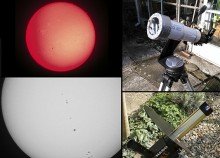Having recently discussed some observing options (binary stars) when the moon’s getting in the way, I thought it might be a good time to discuss observing our nearest star: the sun. First things first, though, a warning: Never, ever, look directly at the sun, whether with the naked eye, whilst wearing sunglasses, or through binoculars or a telescope, without taking proper precautions (i.e. using a specially-made solar filter or a special solar telescope). The risk of serious and permanent eye damage is very real! Now, with that out of the way, let’s get started. What do you need for solar observing, and what you can expect to see.
What do you need? Well, any standard telescope or binoculars can be used for solar observing so long as suitable filters are used. It’s possible to buy ‘white light’ solar filters to securely fit on the front of a telescope or binoculars from astronomy equipment suppliers, such as First Light Optics or Telescope House. Such items include Astrozap’s Baader Solar Filters, which come in a variety of diameters to fit different telescopes. It’s also possible to buy the Baader Solar Film filter material separately (around £20 for an A4 sheet) and make your own (which is what I did; there’s a tutorial on making a solar filter here: https://www.baader-planetarium.com).
The Baader filter material blocks out 99.9% of the sun’s light, making it safe to use. The sun appears white, with sunspots appearing as dark patches on the surface. Depending on your equipment, your eyesight, seeing conditions, etc, you may be able to see the inner and outer areas of the sunspots, known as umbra and penumbra respectively. You may also be able to detect granulation (caused by convection currents) on the sun’s surface, where the sun appears to have the texture of an orange, for example.
With a camera attached to the telescope (or even a smartphone held against the eyepiece), it’s possible to take pretty decent photos of the sun in white light.
As well as filters that fit on the end of the telescope, so called ‘Herschel Wedge’ diagonals are available, and these fit between the eyepiece and the telescope/camera, turning the viewing angle through 90 degrees. Theyprovide better contrast and greater detail, but, most importantly, deflect all the dangerous heat away from the eye or camera. White light wedges (such as those available from Lunt) retail for around £120, whereas red light (sometimes called Hydrogen Alpha) filters are much more expensive (£400+). Even these are recommended to have additional Energy Rejection Filters (ERFs) fitted over the telescope objective, and these can cost as much again making this method too expensive for many people. There are also dedicated solar telescopes available, such as the Coronado PST – these are very popular, though cost in excess of £700 (new).
Red light/hydrogen alpha filters limit the light we see to just a narrow wavelength, and, in doing so, allow fantastic views of prominences, long dark filaments, flares and more. Whereas white light reveals a relatively placid, pale orb, with the odd dark spot on the surface, red light observing reveals the full awe-inspiring majesty of the star. I recently had the opportunity to view the sun using my friend Max’s Coronado PST (red light) and large Skywatcher refractor white light setup. Amazing views, with, in the red light setup, massive flares spreading from the edges of the star, granulation clearly visible, and large filaments across the sun’s disk. Using white light, sunspots (with clear umbra and penumbra) were pin sharp.
It’s fascinating to observe the sun over the course of several days, watching sunspots (many times bigger than the Earth) slowly traverse the solar surface (white light), or prominences and filaments develop and grow (HA). Although we’re currently in a relatively calm period in the solar cycle (the sun has a roughly 11 year solar sunspot cycle between its maximum and minimum activity), there’s always something to see. In addition, there’s a transit of Mercury on May the 9th, so that’s another reason to get ready for some solar observing! As well as the above specialised approaches, special solar filter glasses (of the kind sold in preparation for solar eclipses) are available, and the solar projection method also yields good results.
At this point I feel it important to repeat my earlier caution: Never, ever look directly at the sun without taking suitable precautions and using specialist equipment (sunglasses aren’t enough!).
The accompanying picture shows (clockwise from top left): The sun in Hydrogen Alpha (courtesy Wikimedia); my refractor with home-made white light solar filter; Coronado PST solar telescope; the sun in white light, complete with sunspots (I took this photo myself).
Finally, a big ‘thank you’ to Max Griffith for his valuable input on this piece.
What’s up?
With the full moon gone from the evening skies now for another couple of weeks, it’s the perfect time to get back to observing the fantastic galaxies in Leo, Coma Berenices, Virgo, and Canes Venatici. Jupiter, too, is still well placed at the moment. To the south lies the constellation of Hydra, the largest of all constellations in the night sky. Regarded by many as one of the dullest constellations, it is, nevertheless, home to a spectacular object: the ‘Ghost of Jupiter’ planetary nebula. Appearing star-like in binoculars and low telescopic magnifications, higher magnifications will reveal clear structure, hints of colour, and the white dwarf at its centre. Also nearby is the Spindle galaxy (Caldwell 53). Although technically within the constellation of Sextans, this beautiful, edge-on galaxy is well worth checking out.
Clear skies!
Kevin Quinn is an amateur astronomer based in Cerne Abbas. He is the proud owner of a ten-inch reflector, a small refractor, a case of eyepieces, and a couple of pairs of binoculars. He tweets via @CerneAstro, and blogs via theastroguy.wordpress.com.
©Kevin Quinn







